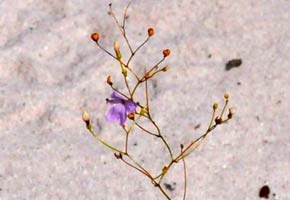

In an article published in PNAS, scientists in Brazil, Australia and the United States describe how they proved that Philcoxia is carnivorous (PNAS)
In an article published in PNAS, scientists in Brazil, Australia and the United States describe how they proved that Philcoxia is carnivorous.
In an article published in PNAS, scientists in Brazil, Australia and the United States describe how they proved that Philcoxia is carnivorous.

In an article published in PNAS, scientists in Brazil, Australia and the United States describe how they proved that Philcoxia is carnivorous (PNAS)
By Karina Toledo
Agência FAPESP – At first glance, Philcoxia minensis, only about 20 centimeters in height, appears to be a delicate plant, with small purple flowers and thin branches. But, under the white sands of Serra do Espinhaço in Minas Gerais, it hides a secret: sticky leaves the size of the tip of a needle that attract, capture and digest unsuspecting worms.
The discovery was described in the Proceedings of the National Academy of Sciences (PNAS) by Brazilian, American and Australian researchers and is the result of the scientific initiation project “Foliar absorption of animal-derived nutrients as a carnivory test in Philcoxia minensis P. Taylor & V. C. Souza (Plantaginaceae),” developed by Universidade Estadual de Campinas (Unicamp) student, Caio Pereira, through a FAPESP fellowship.
The hypothesis that P. minensis is a carnivorous plant was raised in 2007 by botanist Peter Fritsch of the California Academy of Sciences in the United States.
“Fritsch verified the presence of adhesive glands in the leaves and of a large number of nematode worms stuck to the foliar surfaces. He, therefore, made a key-contribution to the theoretical development of the work,” affirmed Rafael Oliveira, coordinator of the study conducted at Unicamp.
The U.S. scientist, however, had not managed to prove that P. minensis was capable of digesting its prey, a mandatory condition for the plant to be considered carnivorous.
To test this theory, Oliveira’s team created a colony of bacteria marked with nitrogen isotopes. These bacteria were offered as food to worms, which, in turn, were offered to the plant.
By analyzing the leaves after the experiment, the scientists detected the presence of the nitrogen isotopes, an indication that the plant had, in fact, digested the nematodes and absorbed their nutrients.
“Additionally, we detected the presence of phosphatases, enzymes that can digest nematodes,” explains Oliveira. This reinforces the hypothesis that the plant does all the work alone, without the need for fungi or other microorganisms to process the prey.
According to the researchers, this strategy of capture is unique among carnivorous plants and probably emerged because of a combination of factors. “The Philcoxia is found in very white sands that are weak in nutrients but have an abundance of nematodes,” explains Oliveira.
Furthermore, the sand particles are translucent, making it possible for the plant to conduct photosynthesis even with leaves that are below ground.
“The solar radiation and the air temperature in this habitat are very high, but the availability of water is low. These extreme conditions make the survival of the majority of plants difficult but could have favored the natural selection of the Philcoxia’s peculiar habit,” he said.
In addition to P. minensis, another two species comprise the Philocoxia genus: P. bahiensis and P. goiasensis. All of the species grow solely in the Brazilian Cerrado.
“The study was conducted solely with the P. minensis, but the discovery should apply to the two other species because they share the same characteristics,” affirmed Oliveira.
Until now, stressed the article’s scientists, there was no evidence of carnivorism in the Plantaginaceae family, to which Philcoxia and another 2,000 species belong.
Cost-benefit
Carnivorous plants account for 0.2% of the angiosperms and are generally restricted to locations with plenty of light and few nutrients. In Brazil, the largest number of species is found in the Cerrado.
Insects are the preferred food on the menu, which also includes microscopic aquatic organisms, protozoans and even vertebrates. “There is a recent study showing that a species of Nepenthes asiatica can digest small rats,” comments Oliveira.
The PNAS article is the first to include nematode worms among the victims. “These plants have mechanisms to attract and digest small animals and at least some of the nutrients necessary for its survival is obtained from this prey.”
“The theoretical model predominantly proposes that the production costs and maintenance of structures related to carnivorism would only be worth it in extreme conditions” say the authors.
“The leaves are generally photosynthesizing, but in carnivorous plants, they also function like a trap. This double role diminishes the photosynthetic capacity. For this reason, according to the theoretical model used, carnivorism only affords energetic benefits to plants in conditions of low nutrient availability and high radiation,” explain the researchers.
But, unlike the majority of carnivorous plants, adds Oliveira, Philcoxia has high concentrations of nutrients in its leaves, suggesting that it is very efficient at the photosynthetic process.
“It is one of the few known cases in the literature that supports one of the two energetic advantages of carnivorism: a possible increase in the photosynthetic rate due to the increased concentration of nutrients in its leaves.”
The article “Underground leaves of Philcoxia trap and digest nematodes” by Rafael Oliveira and others can be read by PNAS subscribers at www.pnas.org/content/early/2012/01/04/1114199109.
Republish
The Agency FAPESP licenses news via Creative Commons (CC-BY-NC-ND) so that they can be republished free of charge and in a simple way by other digital or printed vehicles. Agência FAPESP must be credited as the source of the content being republished and the name of the reporter (if any) must be attributed. Using the HMTL button below allows compliance with these rules, detailed in Digital Republishing Policy FAPESP.





